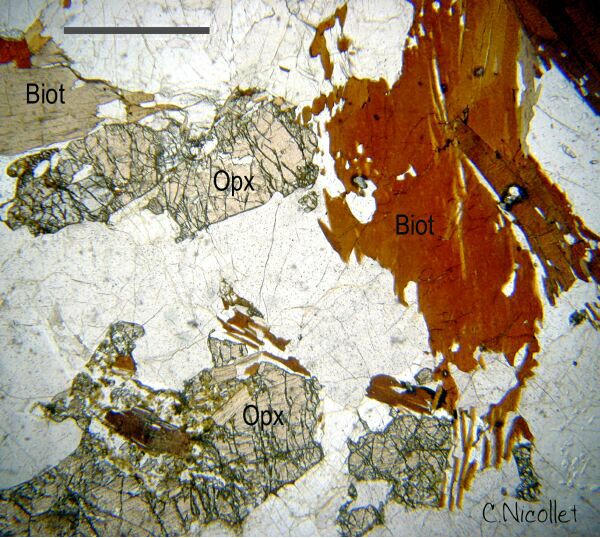Charnockites
Definition - Charnockite is a granitic rock containing orthopyroxene (left photo), with or without biotite, sometimes amphibole and garnet (right photo), ...


Charnockite from Ansignan in the Agly massif, Pyrenees. On the left picture, the orthopyroxene is grey, associated with black biotite. At the edge of the charnockite massif, the garnet (on the right of the photo) completes the paragenesis of the rock; next to the coin, the orthopyroxene is brown.
...
'opaque' minerals (metal oxides) in addition to the leucocratic minerals of granite : quartz, plagioclase and potassium feldspar. This charnockite may have a metamorphic origin; it then has the texture of metamorphic rocks: foliation or metamorphic layering. This is known as charnockitic gneiss. It may have a "granitic" magmatic origin. In this case, it has a igneous granular texture.

Microphotograph (in PPL) of a thin section of the Charnockite d'Ansignan (massif de l'Agly, Pyrénées).
Opx : orthopyroxene,
Biot : biotite ; Q : quartz ; F : feldspath ; the segment is about 1 mm long
- click on the picture to see in XPL.
What is the difference between granite and charnockite? It is the replacement of the hydrous ferromagnesian mineral, biotite, by orthopyroxene, a mineral of similar composition, but anhydrous: in simple terms, charnockite is an 'anhydrous' granite.
The name Charnockite was defined by Holland in 1900, in the name of Jacob Charnock (founder of Calcutta) whose tomb is made of this rock, which is abundant in India. In France, there is only one massif of significant size (a few km2): the Charnockite of Ansignan in the north Pyrenean Hercynian massif of Agly (south of St Paul de Fenouillet).
A PT diagram - Let us illustrate graphically (figure below) the metamorphic evolutions in the high metamorphic grades, at the transition of the
amphibolite facies (Am) - granulite facies (G)
- anatexis (An). Metamorphic transformations take place through deshydration reactions
of the type H = A + V where H and A are respectively hydrous (H) and anhydrous (A) minerals or mineral assemblages. In fact, the evolution is continuous and the minerals are less and less hydrated towards high temperatures.
In extreme cases, at high temperatures, all minerals are anhydrous and we are in the conditions of the granulite facies (domain G on the figure). V is the Vapour phase which is essentially water (H2O), sometimes diluted with carbon dioxide (CO2) and other "gases" in small quantities, to which various ions are added.

In this figure, we represent the dehydration reaction: Biotite + Quartz = orthopyroxene + potassium feldspar + vapor.The other three reactions in the diagram are melting reactions that mark the boundary between the metamorphic transformations and the magmatic or anatexis (or migmatisation) domain (An domain in the figure). These reactions are of 2 types: Biotite + Quartz + potassium feldspar + vapor = Magma ; orthopyroxene
+ potassium feldspar + Quartz + vapor = Magma on the one hand and Biotite
+ Quartz = Magma + orthopyroxene+ potassium feldspar on the other hand.
The first two are "classical" melting reactions called eutectic (or congruent) melting reactions. The 3rd produces a magma and a new mineral (peritectic or incongruous fusion reaction). It can be noticed that the eutectic reactions consume the vapour phase, whereas the incongruous reaction neither consumes nor produces any.
Let us now take three examples of metamorphic gradients: the dark dotted arrow corresponds to a medium pressure gradient (MP or IP: intermediate pressures); the other two arrows (light grey dotted lines), at lower pressures, correspond to low pressure gradients (LP or, in the case of the most LP, contact metamorphism).
Origins of charnockites - A set of rocks of appropriate compositions is metamorphosed under the conditions of a MP gradient; At high temperatures, these rocks reach amphibolite facies conditions (Am domain on the figure), then anatexis conditions: they partially melt (Biotite
+ Quartz + potassium feldspar + vapor = Magma) and produce migmatites or migmatitic or anatectic gneisses. In common, the conditions for the reaction Biotite
+ Quartz = Magma + orthopyroxene+ potassium feldspar are not reached.
In the reverse, under very low pressure conditions (highest dotted grey arrow in the figure), the rocks pass through the reaction: Biotite + Quartz = orthopyroxene + potassium feldspar + vapor and become charnockitic gneisses of the granulite facies. These rocks, dehydrated, will not melt, because water is not available for the reaction orthopyroxene + potassium feldspar + quartz + vapor= Magma.
Let us consider the intermediate case.
The reaction
Biotite + Quartz + feldspath potassique + vapeur = Magma
is crossed. The melting begins (migmatites surround the Ansignan charnockitic massif). The vapour available in the rock is quickly consumed; if the temperature increases further, the reaction Biotite
+ Quartz = Magma + orthopyroxene+ potassium feldspar (that does not require water) is then crossed (at lower T than at MP) and the melting produces a charnockitic magma.
In summary - Two origins are possible for charnockites: metamorphism under granulite facies conditions and anatexis at high T. These explanations remain simplified, as I have not considered the diversity of fluids and their partial pressures in the vapour phase, which play a major role in the extreme conditions of metamorphism!

Microphotograph (in PPL) of a thin section of the Charnockite d'Ansignan (massif de l'Agly, Pyrénées);
the segment is about 1 mm long - - click on the picture to see in PPL
 Back to Photo Gallery or to the Home Page?
Back to Photo Gallery or to the Home Page?




